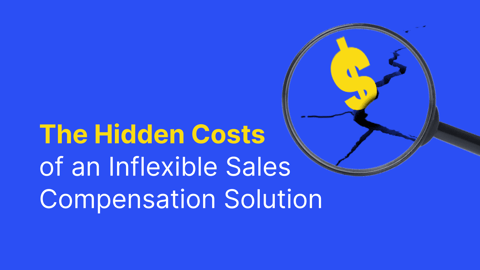As a CMO, I frequently speak with sales and revenue leaders who share their frustrations with sales performance management (SPM) solutions. One recurring issue I hear is that legacy compensation systems simply can't scale with the evolving complexity of today's businesses.
One CRO I recently spoke with summed it up perfectly:
"Despite escalating issues to the vendor's CEO and bringing in a dedicated SWAT team, persistent challenges remain unresolved. The system lacks the flexibility to handle our compensation structure without requiring extensive workarounds."
This scenario is far too common. Many sales organizations begin with basic compensation systems that work well at first, only to find themselves struggling when their needs evolve. What starts as a solution quickly becomes a constraint.
Why Do Compensation Systems Fail at Scale?
Over time, growing sales teams face challenges that many legacy SPM solutions simply aren't built to handle. These include:
1. Fragmented Tech Stacks Lead to Integration Nightmares
Most legacy platforms weren’t built as a single, cohesive system. They’re often pieced together through cobbled-together acquisitions, resulting in disconnected tech stacks that don’t integrate well. For example, platforms that jerry-rig separately acquired tools for quota planning, forecasting, and compliance often experience:
- Limited data visibility across functions – Sales, finance, and leadership pull reports from different systems, leading to conflicting numbers and misaligned decisions.
- Manual interventions to bridge gaps – Ops teams spend hours exporting, cleaning, and reconciling data in spreadsheets just to ensure accurate payouts.
- Slow performance due to disconnected systems – Processing commissions can take days, delaying roll-out for incentive updates and frustrating sales teams.
Without a unified system, sales ops and finance teams end up managing compensation in spreadsheets, manually adjusting numbers, and chasing down errors. Instead of focusing on strategy, they spend their time fixing mistakes.
2. Rigid Workflows That Struggle with Complex Sales Structures
Legacy compensation solutions tend to rely on preset workflows and formulas, which can’t adapt to the dynamic needs of modern sales organizations. As businesses scale, these rigid structures create unnecessary complexity:
- Hierarchies across regions and product lines – Compensation plans struggle to account for varying commission structures, territories, and team overlays. Teams end up doing manual calculations just to confirm the system is correct.
- Extended approval processes – Sales leaders and finance teams are forced into lengthy, manual approval chains, delaying compensation adjustments.
- Quota adjustments based on fiscal year changes – Simple quota updates become multi-step IT projects, requiring consultants or workarounds to deal with market shifts.
Companies with these challenges often find themselves trapped in a cycle of expensive customizations just to stay operational.
If making a simple quota change requires multiple approvals, IT involvement, or external consultants, it’s a sign your system could be working against you.
3. High Total Cost of Ownership (TCO) Without Predictable ROI
A recurring concern I hear from executives is the high ongoing costs of maintaining their current platform. One leader noted:
"To administer needed changes, we’re spending anywhere from $40,000 to $100,000 annually—just to keep up with our evolving needs."
Many legacy providers require expensive professional services engagements even for minor adjustments, leading to an unpredictable and often unsustainable total cost of ownership.
4. Clunky User Experience
A system that looks great in a demo but slows your team down in practice isn’t a solution. t’s a problem. These systems make even simple administrative tasks complicated, frustrating users and slowing down productivity. Some common complaints include:
- Too many screens required for simple tasks like adding users
- Sales reps can’t get answers on their own. They’re constantly asking sales ops for updates on their earnings.
- IT is stuck handling simple updates.
If your team is spending more time managing the system than benefiting from it, it’s probably not supporting your business. It’s just slowing you down.
5. Scalability Issues That Hinder Business Growth
As your business grows, sales compensation gets more complex. More reps, new product lines, and expanded territories all require a system that scales with you. Too often, companies find their compensation platform falling behind, creating frustration, inefficiencies, and costly workarounds.
I hear this from other executives all the time:
- Running reports takes forever. Your team can’t get the data they need because the system lags under the weight of your sales org.
- Comp plans become a tangled mess. What started as a simple structure now requires endless workarounds to handle different regions, roles, and commission models.
- Making adjustments feels impossible. A territory or quota change shouldn’t mean weeks of approvals, IT tickets, and consultant fees just to keep things running.
If the points above feel familiar, you’re not alone! Many legacy systems struggle with these challenges, forcing businesses into a reactive compensation strategy, rather than the proactive stance they all want to take.
What to Look for in a Scalable Incentive Compensation Solution
By now, you’ve probably experienced some of these challenges firsthand. Maybe your team spends too much time fixing compensation errors. Maybe small changes take weeks when they should take minutes. Or maybe your sales reps are constantly asking, “Where can I see my commission details?”
The good news is that a better system isn’t just possible. It’s available now. And it’s easy to implement! Here’s what to look for:
- Unified Data and Process Automation: A single, integrated platform that reduces complexity and ensures data integrity across functions. Your finance, sales, and operations teams should all be working from the same real-time data instead of chasing down numbers across disconnected systems.
- Configurable Workflows: A flexible approach that allows businesses to adapt without costly customizations. Adjusting compensation plans, quotas, and territories shouldn’t feel like a major project. A scalable system makes these changes simple.
- Clear, predictable costs. You shouldn’t need a separate budget just to maintain your compensation system. Look for a pricing model that doesn’t require ongoing professional services just to keep things running.
- Intuitive User Experience: Reps should be able to check their commissions easily. Sales ops should be able to adjust plans without needing outside help. If a system is frustrating to use, adoption will suffer.
- Enterprise-Grade Scalability: Your compensation system should keep up as your business grows. Whether you're expanding into new markets, adding more reps, or adjusting complex compensation plans, the system should handle it all smoothly without slowdowns or costly customizations.
An Incentive Compensation System Built to Scale
At some point, every growing company reaches this crossroads. Some continue pushing forward with workarounds, hoping their system can hold up a little longer. Others take a step back and ask, Is this still the right fit for where we’re headed?
A scalable compensation system isn’t just about handling more reps or bigger datasets. It’s about giving your team the flexibility, visibility, and control they need to drive performance. The companies that get this right don’t just compensate sales teams efficiently. They create a foundation for long-term, predictable revenue growth.
Don’t let your compensation system become a roadblock to success. Explore how a purpose-built solution can empower your sales teams and drive better business outcomes.



